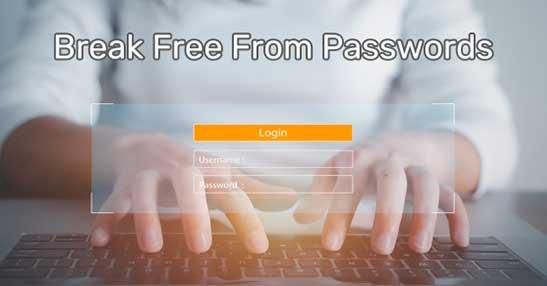
Nearly half of Americans (46%) admit to having their password stolen in 2023. Yet many organizations still rely on passwords, leaving their systems and user information at risk of security breaches and financial losses.
This continued reliance on passwords is especially concerning considering passwords are often easily compromised through tactics like social engineering, phishing or brute force attacks. Managing them can also be cumbersome for IT teams, due to the need to handle frequent password reset requests. Finally, remembering many different passwords for different applications and devices is a significant burden on employees, too.
To streamline workflows while protecting against the rising tide of cyberthreats, organizations must make the transition away from passwords to more secure, user-friendly passwordless authentication methods. Completely removing passwords from the equation helps organizations reduce their attack surfaces and boost their overall cybersecurity postures.
What is passwordless authentication?
Passwordless authentication verifies a user's identity using non-password credentials like biometrics, digital wallets or passkeys. Often incorporated into security frameworks such as multi-factor authentication (MFA) and single sign-on (SSO), passwordless authentication eliminates the security vulnerabilities associated with passwords while also making login processes more user-friendly.
Almost three-quarters of users (73%) reuse their passwords, exemplifying why traditional passwords are a security vulnerability. By removing the need for users to create, remember and manage passwords, passwordless authentication reduces the risk of password-related breaches and improves the overall user experience.
The benefits of passwordless authentication
By eliminating traditional passwords, organizations can reduce the possibility of password theft, phishing attacks and other cyberthreats. Passwordless systems remove the weak link in security — passwords that are easily guessed or stolen — and fortify defenses against unauthorized access.
Passwordless systems also relieve IT teams from the burden of password resets, which can be time-consuming and costly. Reducing the frequency of resets helps organizations allocate IT resources more effectively so IT teams can focus on strategic initiatives rather than routine maintenance.
Additionally, passwordless authentication improves user experience and accelerates workforce efficiency. Users no longer need to remember complex passwords or undergo frequent password changes, streamlining their access to applications and systems and boosting productivity. And for industries more susceptible to cyberattacks like healthcare, financial services and manufacturing, passwordless solutions help maintain compliance with regulations that mandate robust security measures.
4 examples of passwordless authentication methods
The era of traditional passwords is coming to an end. Transitioning to more secure and user-friendly authentication methods is mission-critical as cyberthreats evolve. If you haven’t yet, now’s the time to consider the following passwordless authentication methods for your organization:
1. Digital wallets
Digital wallets are secure platforms that store mobile credentials and leverage Near Field Communication (NFC) technology for quick and easy logical access control. Leading providers of digital wallets include Apple, Google and Samsung. NFC technology uses magnetic field induction to enable communication between devices like credential readers and mobile wallets.
The relatively short range of NFC, limited to about 10 centimeters, bolsters your organization’s security posture by reducing the likelihood of unauthorized interceptions. While this range may restrict device placement flexibility, it’s beneficial in environments where next-level security is crucial, such as healthcare settings.
2. Passkeys
A passkey is a digital authentication method that replaces traditional passwords with a pair of cryptographic keys. The private key is securely stored only on the user's device — such as a smartphone, tablet, computer or a dedicated hardware security key — and never transmitted over the network, protecting against interception.
Unlike passwords, passkeys don't depend on shared secrets, making them highly resistant to phishing attempts. Passkeys also adhere to Fast Identity Online (FIDO) standards, ensuring compatibility and security across devices and platforms. rf IDEAS facilitates passkey authentication through its ConvergeIDTM passwordless platform which converts existing insecure credentials, such as proximity cards, into FIDO2 security keys.
3. RFID credential readers
Radio-frequency identification (RFID) credential readers are devices that read and authenticate credentials such as RFID cards/ID badges, smart cards, key fobs, mobile credentials or biometric data. These readers are commonly deployed in logical access systems to grant or restrict access to networks, data or endpoints based on the presented credentials. The technology can also read mobile credentials stored in digital wallets.
RFID readers like WAVE ID® can help your organization strengthen security and streamline access control processes by offering efficient, contactless authentication that integrates seamlessly with existing systems.
4. Other common passwordless authentication methods
Other common forms of passwordless authentication include hardware tokens, one-time passwords (OTPs) and authenticator apps. While these methods can eliminate the hassles and security risks of traditional passwords, they also introduce new challenges such as dependence on physical tokens, which can complicate user access.
Instead, the advanced options we’ve already discussed offer the most streamlined approach to access control for both IT teams and users. With rf IDEAS’ portfolio of passwordless authentication solutions, your organization can unlock and provide a better user experience and stronger security protections.
Revolutionize user experience and boost cybersecurity with passwordless authentication
Passwordless authentication solutions are rapidly emerging as the preferred method for minimizing the risks of traditional passwords and securing logical access. However, not all methods are equal. rf IDEAS offers passwordless authentication solutions that deliver improved cybersecurity and a more streamlined user experience. Additionally, our smart card readers are compatible with nearly every existing credential worldwide.
Download the 2024 State of Passwordless Security Report to learn more about how rf IDEAS can enhance your organization's security infrastructure with advanced passwordless solutions.